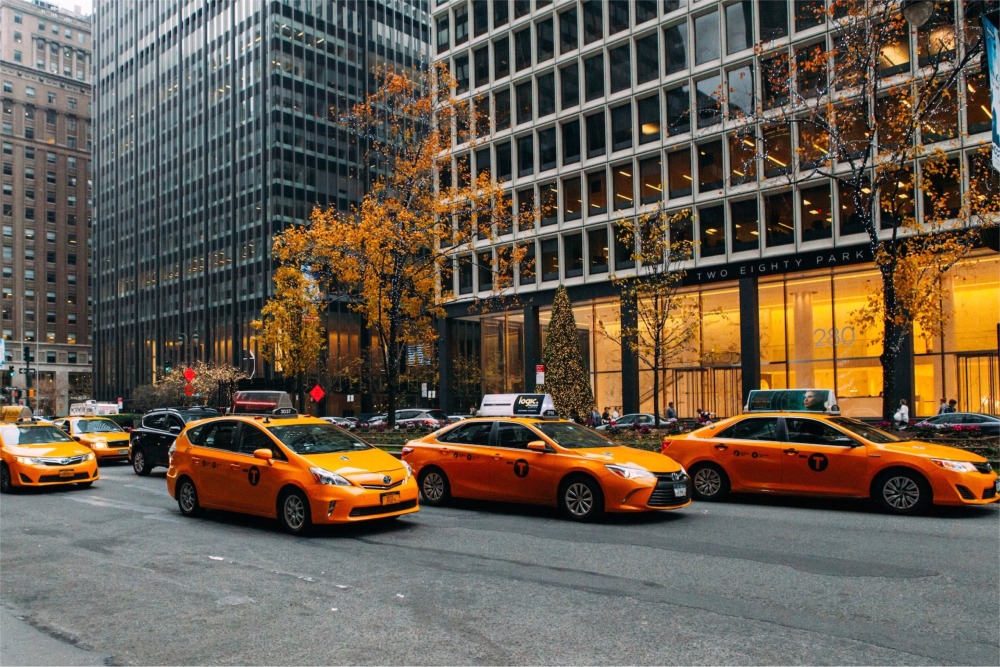New York Yellow Cabs
Home > New York State Photographs > New York > New York Yellow Cabs

The yellow cabs of New York weaved through the streets of East Manhattan, carrying their passengers past 280 Park Avenue — a scene that was as ubiquitous as the buildings that dotted the city's skyline. In each cab was a story being lived and played out in the city. The dreams of the cab drivers — some from far-flung lands, all hoping to make a better life for themselves and their families — and that of their passengers.
Some were going home after a long day's work, some were heading off for a holiday in far-flung corners of the earth, some were headed off on the town for dinner and entertainment; a myriad of lives intersecting and touching each other in the passing of the street lights.
Each passenger had their own unique story — some of joy, some of sorrow, some of heartbreak, some of success, but all were stories that had been lived and were being lived in the bustling streets of New York.
The yellow cabs of New York carried each individual, and their stories, past 280 Park Avenue, carrying them toward the next chapter in their own lives and the lives of the people around them. Together, all the stories of the city combined to create a vibrant tapestry of life, that could only be found in the Big Apple.
New York Yellow Cabs
New York yellow cabs are a distinctive and iconic part of the city's transportation landscape. These taxis are a ubiquitous sight on the streets of New York City, easily recognizable by their bright yellow color and illuminated rooftop signs. Here's a more detailed explanation about New York yellow cabs:
History and Iconic Status
Yellow cabs have been a staple of New York City's transportation system since the early 20th century. In 1907 Harry N. Allen established the New York Taxicab Company, and the color yellow was chosen because it was easily visible from a distance. The iconic yellow color has since become synonymous with taxis in the city.
Regulation and Licensing
Operating a yellow cab in New York City is highly regulated. The New York City Taxi and Limousine Commission (TLC) oversees the licensing, regulation, and enforcement of taxi services. Drivers are required to obtain a taxi license (which is a special license allowing them to operate a taxi legally) and a medallion (a right to operate a taxi and a means for limiting the number of taxis in the city). Medallions were once in high demand due to their limited number, but the rise of ridesharing services like Uber and Lyft has impacted their value.
Vehicle Requirements
Yellow cabs must meet certain standards set by the TLC. These standards include vehicle size, safety features, and fuel efficiency. The vehicles used as yellow cabs are typically sedans or minivans that are spacious enough to accommodate passengers and their luggage comfortably.
Fare Structure
Yellow cabs charge fares based on a metered system. The fare includes a base amount, distance traveled, and any waiting time. Passengers are also responsible for any tolls incurred during the trip. The meter is activated once the taxi starts moving and calculates the fare based on time and distance.
Accessibility
New York yellow cabs are required to be accessible to people with disabilities. This means that a certain percentage of the fleet must be wheelchair accessible, and drivers are trained to assist passengers with disabilities.
Competition and Challenges
The rise of ridesharing services like Uber and Lyft has introduced competition to the traditional yellow cab industry. These services offer more flexibility and convenience through smartphone apps. This competition, along with the cost of taxi medallions, has posed challenges to the traditional yellow cab model.
Cultural Symbol
New York yellow cabs have become an iconic symbol of the city and are often featured in movies, TV shows, and photographs depicting the bustling streets of New York. Their bright yellow color and unique design make them instantly recognizable to both residents and tourists.
In recent years, the taxi industry in New York City has faced significant changes and challenges due to the advent of ridesharing services and shifts in consumer preferences. However, yellow cabs still hold a special place in the city's cultural identity and transportation history.


